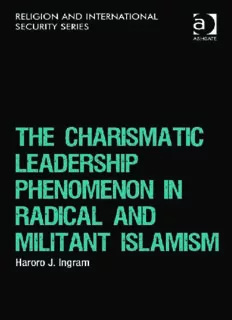
The Charismatic Leadership Phenomenon in Radical and Militant Islamism PDF
Preview The Charismatic Leadership Phenomenon in Radical and Militant Islamism
The CharismaTiC Leadership phenomenon in radiCaL and miLiTanT isLamism The charismatic leaders of the radical Islamist movement – from Sayyid Qutb to Osama bin Laden – are analysed in this intriguing study. It shows how they build on chains of charismatic leadership in order to craft their own authoritative images. This is a study that tells us much about the human side of radical Islamist ideology, and about the role of leadership in social movements in general. mark Juergensmeyer, University of California, Usa religion and international security series editor: Lee marsden, University of east anglia In the twenty-first century religion has become an increasingly important factor in international relations and international security. Religion is seen by policy makers and academics as being a major contributor in conflict and its successful resolution. The role of the ashgate series in religion and international security is to provide such policy makers, practitioners, researchers and students with a first port of call in seeking to find the latest and most comprehensive research on religion and security. The series provides established and emerging authors with an opportunity to publish in a series with a reputation for high quality and cutting edge research in this field. The series produces analytical and scholarly works from around the world that demonstrate the relevance of religion in security and international relations. The intention is not to be prescriptive or reductionist in restricting the types of books that would be appropriate for the series and as such encourages a variety of theoretical and empirical approaches. International security is broadly defined to incorporate inter and intra-state conflict, human security, terrorism, genocide, religious freedom, human rights, environmental security, the arms trade, securitisation, gender security, peace keeping, conflict resolution and humanitarian intervention. The distinguishing feature is the religious element in any security or conflict issue. Other titles in the series: Radicalism Unveiled Farhaan Wali 978-1-4094-6371-9 The Ashgate Research Companion to Religion and Conflict Resolution Edited by Lee Marsden 978-1-4094-1089-8 Religious Transnational Actors and Soft Power Jeffrey haynes 978-1-4094-2508-3 Religion, Conflict and Military Intervention Edited by Rosemary Durward and Lee Marsden 978-0-7546-7871-7 The Charismatic Leadership phenomenon in radical and militant islamism haroro J. ingram Australian National University (ANU), Australia © haroro J. ingram 2013 All rights reserved. No part of this publication may be reproduced, stored in a retrieval system or transmitted in any form or by any means, electronic, mechanical, photocopying, recording or otherwise without the prior permission of the publisher. Haroro J. Ingram has asserted his right under the Copyright, Designs and Patents Act, 1988, to be identified as the author of this work. Published by Ashgate Publishing Limited Ashgate Publishing Company Wey Court east 110 Cherry street Union road suite 3-1 Farnham Burlington, VT 05401-3818 surrey, gU9 7pT Usa england www.ashgate.com British Library Cataloguing in Publication Data A catalogue record for this book is available from the British Library The Library of Congress has cataloged the printed edition as follows: ingram, haroro J. The charismatic leadership phenomenon in radical and militant Islamism / by Haroro J. ingram. pages cm. -- (Religion and international security) ISBN 978-1-4094-4984-3 (hardback) -- ISBN 978-1-4094-4985-0 (ebook) -- ISBN 978-1-4724-0269-1 (epub) 1. Islam and politics. 2. Islamic leadership. 3. Radicalism-- Religious aspects--Islam. I. Title. Bp173.7.i55 2013 320.55'7--dc23 2013007974 ISBN 9781409449843 (hbk) ISBN 9781409449850 (ebk – PDF) ISBN 9781472402691 (ebk – ePUB) III This book is dedicated to my parents This page has been left blank intentionally Contents List of Figures and Table ix Introduction 1 Part I EstablIshIng thEory 1 Literature Review: Charismatic Leadership Theory 11 2 A Theoretical Framework of Charismatic Leadership 27 3 A Theoretical Framework of Identity and the ‘Architects of Identity’: Merging Identity and Charismatic Leadership Theory 49 4 The Radicalisation Process and the Role of the Charismatic Leader: Merging Radicalisation and Charismatic Leadership Theory 63 Part II EstablIshIng ContExt 5 Islam as Centre and the Charismatic Leaders of Islamist Radicalism and Militancy: Exploring the Islamic ‘Toolkit’ 77 6 The Transformative Charisma Phenomenon in Islamist Radicalism and Militancy: A Framework of Macro-level Trends and Characteristics 95 Part III CasE studIEs 7 The Colonial Period (late 1800s-1945): The Roots of the TCPIRM: Hassan al-Banna 107 8 The Post-Colonial Period (1945-1970): From the Chasm between Hope and Reality: Sayyid Qutb 121 9 The Modern Period I: Islam’s Resurgence (1970-1989) The Dawn of Perpetual Crisis, the Beginning of Perpetual War: Abdullah Azzam 139 viii The Charismatic Leadership Phenomenon in Radical and Militant Islamism 10 The Modern Period II: Post-Afghan Jihad to the 9/11 Decade (1990-2000s): From the Depths of Islam’s Modern Crisis: Osama bin Laden 165 11 The Modern Period III: The 9/11 Decade (2001-2011), Crisis on the Frontiers of the Muslim World: Anwar al-Awlaki (1971-2011) 199 Conclusion 225 References 231 Index 251 List of Figures and Table Figures I.1 Theory, Context and Case Studies 5 2.1 Recognition of Charismatic Authority 28 2.2 The Charismatic Relationships 30 2.3 Relationship Triangle 1 31 2.4 Relationship Triangle 2 32 2.5 Perceptual Triangle 32 2.6 Manipulation Triangle 33 2.7 The Charismatic Relationships 34 2.8 The Three Dimensions of Routinisation 40 2.9 The Routinisation of Charisma 41 2.10 Centring 43 2.11 The Transformative Charisma Phenomenon 43 3.1 Identity Formation and Production 51 3.2 Cyclical Cognitive Reinforcement: The Drivers of Identity, Perception of Crisis, and the In- and Out-group Identity Paradigms 55 3.3 The Identity Formation/Production Process 57 3.4 Spheres of Identity 57 3.5 Primacy of an Identity 59 3.6 The Uni-polarisation of Identity 60 4.1 The Radicalisation Process 66 5.1 Four Ideal Types of Islamic Orientation 79 5.2 Cognitive Transitions in the Radicalisation Process 81 6.1 Chains of Transformative Routinisation 96 6.2 Typologies of Charismatic Leadership in Modern Islamist Militancy 101 9.1 Abdullah Azzam 147 10.1 The Al-Qaeda Embryo 172 10.2 The Al-Qaeda Charismatic Adhocracy 173 10.3 The Impact of the War on Terror on Al-Qaeda 176
Description: